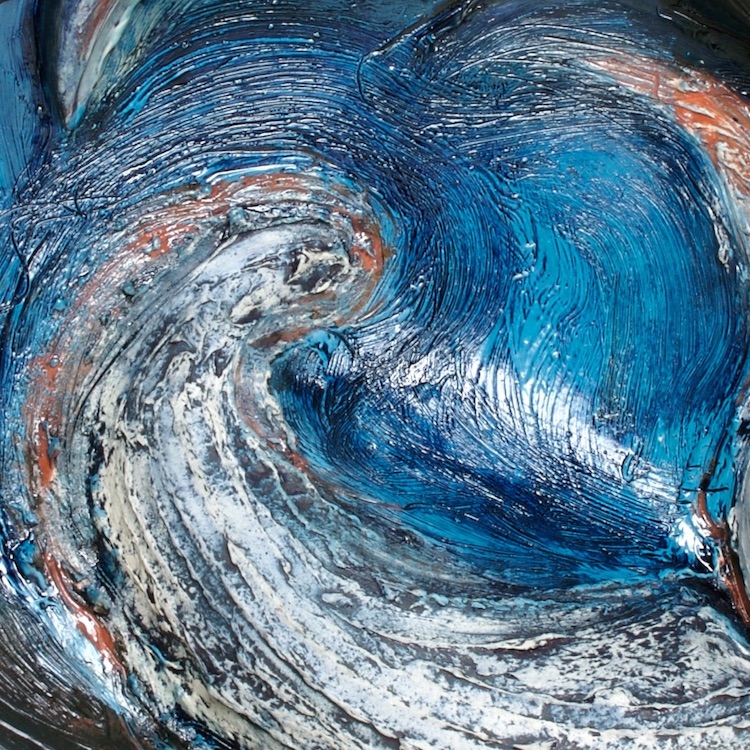The following is an essay by Paul Kotula in which he discusses Susanne Stephenson’s retrospective exhibition SUSANNE STEPHENSON | TRANSFIGUREMENT at Pewabic Pottery (March 9 – May 13, 2018). Kotula is a ceramist, educator, gallerist and writer.
DETROIT––For six decades, Susanne Stephenson has transformed clay into ‘landscapes’ that capture nature’s poetic power. She has done so through the eyes of a painter. Stephenson has moved pigmented ceramic material abstractly like painters Paul Cezanne, Ernst Ludwig Kushner and Emil Nolde but, unlike them, she has done so in dialogue with the spiraling movement synonymous with the potter’s wheel and the gestural expression the tool inspires. To that extent, her embrace of the throwing process is a perfect vehicle for her to celebrate the cyclical patterns of nature and their fleeting variations of the past. For each of Stephenson’s vessels is a record her presence in nature at a particular time of year and day, when “the fog appears to visually fuse rock and wave” or when sunlight “cuts a sharp crevasse of light in the dark mountain and sky.”
Featured image: Blue Wave, 2007

Installation view

Bronze Luster Trojan Soup , 1976
While her early studies were in painting, Stephenson made a conscious choice to present her ideas through the intimacy of pottery form. In doing so, her work elicits our primal being whose perception of touch developed before sight. While color and gesture are paramount to the visual experience of her work, Stephenson delivers human-scale vessels with thickly textured strokes of painted color, sensual and rough edges and unique empty volumes that curious hands delight in exploring. Traditional painting cannot offer such experiences.

Cut Edge Water Rush, 2000

Garden Cage IV, 2011
Stephenson’s forms are far from classical, but to work classically would deny portraying nature’s true beauty. Her means of “making” replicates a process of growth that mimics nature; where an internal energy force grows outward to become what it must. Through this process, to paint in space, Stephenson has generated forms previously unseen in the history of ceramics. Undoubtedly, her work is part of the lineage established by Peter Voulkos – she shares his abstract expressionist affinities – but her work also has a sense of the majestic that Maija Grotell, her mentor at Cranbrook Academy of Art, brought to her vessels, and a sense of place that Robert Turner instilled in his work. Her use of joyous color at times is reminiscent of her contemporary Betty Woodman, but her palette, and its spirited application (particularly that of her work made in terracotta), seem more connected to paintings by the German Expressionists or to contemporary landscape paintings by artists such as David Hockney.

Orange Wave, 1996
Ultimately, Stephenson’s creations leave us in awe of her ability to transcend the medium, to remind us what it feels like to be in the presence of nature’s greatness––of mountains so dense, skies or seas so vast––that we recognize our corporeal being at that moment and place. Yet, nature’s power can manifest itself in other ways. Stephenson’s late work records the abundant pot holes of Michigan roads that result from the roads freezing and thawing; reminding humankind of its faulty attempts to control nature. Hence, Pewabic Pottery’s presentation of this retrospective survey is timely. Stephenson, like many women that transformed contemporary ceramics, is not only deserving of further recognition, her subject gives us pause. This exhibition comes in an era when profiting off nature seems more important to some than preserving it, even as hurricanes, earthquakes, fires and mudslides destroy vast communities. Stephenson offers us not only an antidote to such madness, she delivers an impassioned call to respect all of earth’s wonders.
––Paul Kotula, March 2018

Red Beach, 1993

Road Decay XVIII, 2016-18

Sky Water, 1987-90

Slice Edge Vase II, 1985

Installation view
Love or loathe this exhibition from the world of contemporary ceramic art and contemporary ceramics? Share your thoughts in the comments section below.

This is timely!
Susanne, lovely to see your work in this setting—-it’s been a long time since we went ice skating!
I live in Arizona now.
Not making clay objects now, but still feel drawn to all of it.